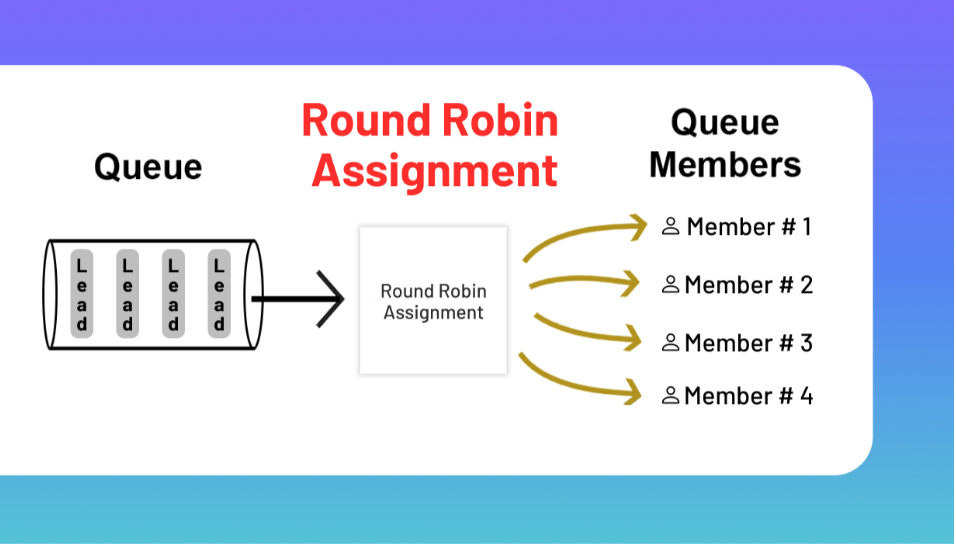Live chat queueing is a valuable tool for businesses looking to provide efficient and effective customer support. Using live chat queueing strategies, businesses can optimize their customer service operations and enhance the overall customer experience.
What is Live Chat Queueing
Live chat queueing is a system that organizes customer inquiries or chats based on their arrival time. The system’s goal is to ensure that customers are served in the order they join the queue. When customers initiate a chat, they are placed in a virtual queue until an available agent becomes free to assist. This not only ensures a fair and orderly process but also helps agents manage their workload effectively.
One key aspect of chat queue is its ability to handle multiple chats simultaneously. By efficiently managing incoming requests, businesses can reduce customer wait times and improve their response times.

Benefits of Live Chat Queueing
Implementing a live chat queueing system can greatly benefit businesses in various ways. Firstly, it allows for better customer service by ensuring that each customer is given equal attention and assistance. The queueing system eliminates any bias or favoritism, providing a fair and equal opportunity for all customers to have their queries addressed.
Moreover, live chat queueing helps businesses streamline their customer support operations. By organizing chats based on their arrival time, agents can prioritize their workload and address inquiries in a systematic manner. This not only improves efficiency but also prevents any confusion or oversight that may occur when handling multiple customer chats simultaneously.
Queueing has the ability to reduce customer wait times. By placing customers in a virtual queue, businesses can ensure that each customer is served promptly and in the order they joined the queue. This eliminates the frustration of waiting for extended periods and enhances the overall customer experience.
Live chat queueing systems often come equipped with features such as estimated wait times and position in the queue notifications. These features provide customers with transparency and reassurance, keeping them informed about their expected wait time and their position in the queue. This proactive communication helps manage customer expectations and reduces anxiety or impatience while waiting for assistance.
Finally, live chat queueing systems can be customized to suit the specific needs and preferences of businesses. They can be integrated with other customer support tools and platforms, such as customer relationship management (CRM) systems, to provide a seamless and comprehensive support experience. This integration allows agents to access customer information and history, enabling them to provide personalized and efficient assistance.
Trending
Live chat is key to modern contact centers, offering instant support via websites, apps, and self-service portals. It simplifies interactions and provides real-time help. Features like routing, analytics, and integration enhance customer experiences and agent efficiency. Live chat boosts engagement, speeds resolutions, and delivers personalized support, making it vital for digital customer service.
Types of Live Chat Queuing
When it comes to live chat queueing systems, there are several types available. Each has its own advantages and use cases. Let’s dive deeper into some of the most commonly used types.
Round-Robin Queueing
The round-robin queueing algorithm is a popular choice for distributing incoming chats evenly among available agents. With this approach, each chat is assigned to the next available agent in a cyclical manner. This ensures that the workload is balanced across the team, preventing any one agent from being overwhelmed while others are underutilized.

Imagine a scenario where a customer support team has five agents. With round-robin queueing, the first chat would be assigned to Agent 1, the second chat to Agent 2, and so on. Once the last agent has been assigned a chat, the cycle starts again with Agent 1. This fair distribution of workload can be particularly beneficial for businesses with similarly skilled agents and a desire for a balanced allocation of chat volume.
Least Busy Queueing
In contrast to round-robin queueing, the least busy algorithm takes a different approach. It assigns incoming chats to the agent with the least active chats at any given time. This means that each chat is routed to an agent who has the capacity to handle it effectively, ensuring that customers receive prompt and efficient support.
Let’s say a customer support team is using the least busy queueing algorithm. If Agent 1 is currently handling three chats, Agent 2 is handling two chats, and Agent 3 is handling one chat, the next incoming chat would be assigned to Agent 3. By distributing chats to agents who are less busy, businesses can optimize their efficiency and potentially increase customer satisfaction.
Priority and Skill-Based Queueing
While round-robin and least busy are two commonly used queueing algorithms, there are other types available as well. Some systems offer priority-based queueing, where certain chats are given higher priority based on specific criteria. For example, a VIP customer may be automatically routed to the most experienced agent. Similarly, a chat related to a critical issue may be escalated to a specialized support team. Implementing skill-based routing involves analyzing the skill sets of agents and categorizing them into different areas of expertise. This can include technical knowledge, product knowledge, language proficiency, and more. By understanding the strengths and weaknesses of each agent, businesses can optimize their customer support operations.
Some live chat queue systems allow for custom queueing rules, giving businesses the flexibility to tailor the queueing algorithm to their unique needs. This can include factors such as agent skill levels, language proficiency, or even geographic location.
Selecting Queue Types for Your Business
When choosing between round-robin and least busy queue types, businesses must consider their specific requirements and priorities.
Round-robin queueing is particularly suitable for businesses where all agents possess similar skills and experience levels. It ensures a fair distribution of workload, minimizing the chances of any one agent feeling overwhelmed or underutilized. Round-robin queueing works by cycling through available agents in a predetermined order. Each incoming chat is assigned to the next agent in line, ensuring that no one agent is consistently overloaded with chats while others remain idle. This approach promotes a balanced workload distribution, which can contribute to a more harmonious and efficient working environment.
However, there are situations where round-robin queueing may not be the most optimal choice. For example, if a business has agents with varying levels of expertise, assigning chats purely based on a predetermined order may not take into account the specific skills required for each chat. In such cases, the least busy queue type may be more suitable.
Least busy queueing focuses on optimizing efficiency by assigning chats to the agent with the fewest ongoing chats. This approach takes into consideration the workload of each agent and aims to distribute chats in a way that minimizes the overall wait time for customers. By prioritizing the least busy agent, businesses can ensure that chats are handled by agents who have the capacity to provide timely and quality support.
Furthermore, the least busy queue type can be particularly beneficial in situations where certain agents may be busier due to specific circumstances. For example, during peak hours or when dealing with complex customer issues, some agents may naturally have more ongoing chats. By assigning chats to the least busy agent, businesses can effectively balance the workload and prevent any single agent from becoming overwhelmed.
Requeue Timeout and Tracking
Requeue timeout is an essential feature of live chat queueing systems. It determines how long a chat request will remain in the queue before being rerouted or escalated to another level of support. Businesses should carefully consider the requeue timeout duration based on their typical response times and customer expectations. A shorter timeout may lead to increased chat abandonment rates, while a longer timeout may result in prolonged wait times and lower customer satisfaction.
When it comes to setting the requeue timeout, there are several factors to take into account. Firstly, consider the nature of the business and the complexity of the support requests. For example, a tech support company dealing with intricate technical issues may require a longer requeue timeout to allow their support agents enough time to provide thorough and accurate solutions.
Secondly, customer expectations play a crucial role in determining the appropriate requeue timeout. Understanding the average response time that customers expect can help businesses strike a balance between minimizing chat abandonment rates and ensuring reasonable wait times.
Furthermore, it is important to consider the workload and availability of support agents. If the support team is already overwhelmed with a high volume of chat requests, a shorter requeue timeout may be necessary to prevent further delays and ensure prompt assistance for customers.
Monitoring Analytics
In addition to the requeue timeout itself, tracking the requeues of a chat can provide valuable insights into the efficiency of the queueing system and the overall support process. By monitoring the number of times a chat is rerouted or escalated, businesses can identify any patterns or bottlenecks that may be hindering the support workflow.
For instance, if a particular support agent consistently receives chats that are rerouted multiple times, it may indicate a need for additional training or specialization in certain areas. On the other hand, if a significant number of chats are escalated to a higher level of support, it could suggest a need for more resources or improved documentation to empower frontline agents to handle a wider range of issues.
By analyzing the requeue data, businesses can make informed decisions to optimize their support processes. This may involve adjusting the requeue timeout duration, implementing targeted training programs, or allocating resources more effectively to ensure a smooth and efficient customer support experience.
To maximize the effectiveness of your live chat support system and deliver the best customer experience, you must ensure that all customer queries are attended to promptly. This is where queue monitoring features come in handy.
The queue monitoring features allow you to track real-time data regarding how many customers are waiting in line to be serviced. This data could range from the total number of people in the queue to the average wait time for customers.
One significant feature that most chat support systems provide is the alert system. This feature facilitates setting up alerts or notifications for when the queue reaches its maximum capacity or when the number of queued customers exceeds a certain limit.
This is highly advantageous for a few reasons:
1. Real-time monitoring of the situation: With this feature, you have a real-time view into the queue, which can help you identify potential gaps and strains on your resources.
2. Optimize resource allocation: By receiving alerts when queues get too long, you can swiftly allocate additional resources to manage the problem, ensuring that all customers receive timely attention.
3. Improve customer satisfaction: Reducing wait times by managing queues effectively can lead to increased customer satisfaction. Sensing a quick response, customers would feel valued and attended.
So, to manage your customers smoothly and enhance their satisfaction levels
, keep an eye on your live chat system’s queue monitoring features. Setting up alerts allows you to be notified on time when the queue nears its maximum capacity or when the number of waiting customers crosses a set threshold. This proactive approach ensures you always have a grasp on the situation and can redistribute tasks among your customer support team to balance the workload whenever necessary.
Moreover, by keeping tabs on these metrics, you can gather insightful data about your peak times and average response times. Such insights can help you make informed decisions about staffing and scheduling. For instance, if your queue becomes overloaded at the same time every day, you might consider assigning more team members during that period.
Further, quick response times and prompt problem resolution are critical factors that influence customer satisfaction. By managing your customer queue effectively, you can reduce wait times, and as a result, improve overall customer experience. Hence, implementing alert systems in your chat support queue can greatly contribute to your business’s success by enhancing customer satisfaction and loyalty.
Recommended Setting for Maximum Number of Chats per Agent
The maximum number of chats per agent setting determines how many simultaneous chats an agent can handle effectively. It is crucial to strike a balance between agent workload and customer satisfaction. Set this value too low, and agents may not feel fully utilized, leading to increased costs per resolution. Set it too high, and agents may become overwhelmed, resulting in longer response times and potentially unsatisfactory customer experiences.
When deciding on the maximum number of chats per agent, factors to consider include agent proficiency, chat complexity, average chat duration, and available agent resources. Regularly monitoring and reviewing this setting ensures that businesses can optimize their operations and maintain high-quality customer service.
Conclusion
Implementing effective live chat queueing systems is crucial for businesses aiming to deliver timely and efficient customer support. By understanding the different types of queueing algorithms, finding the right balance between round-robin and least busy queue types, and carefully configuring settings such as requeue timeout and maximum chats per agent, businesses can create a streamlined and customer-centric support experience. You may see an example of how you may configure queueing in the LIveHelpNow contact center software here.
Consider your specific business needs, team dynamics, and customer expectations when making decisions about live chat queue. Regularly evaluate and adjust the queueing system to maintain optimal performance and enhance customer satisfaction. By leveraging the power of live chat queueing, businesses can provide stellar customer support and build long-lasting relationships with their customers.




